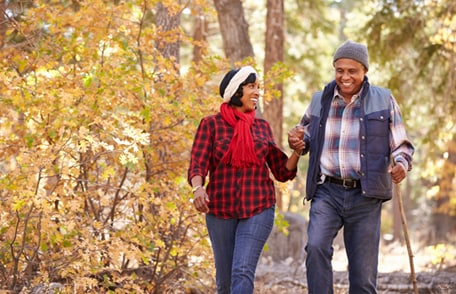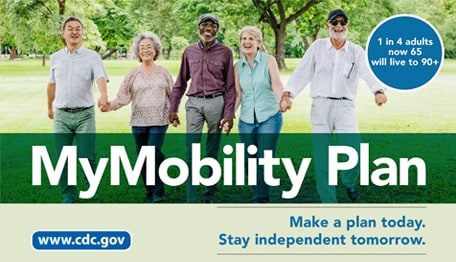Keep on Your Feet—Preventing Older Adult Falls

Falls are common and costly, especially among Americans age 65 and older. But falls are preventable and do not have to be an inevitable part of aging.
Every second of every day, an older adult (age 65+) suffers a fall in the U.S.—making falls the leading cause of injury and injury death in this age group. One out of four older adults will fall each year in the United States, making falls a public health concern, particularly among the aging population.
Facts About Older Adult Falls
- About 36 million older adults fall each year—resulting in more than 32,000 deaths.
- Each year, about 3 million older adults are treated in emergency departments for a fall injury.
- One out of every five falls causes an injury, such as broken bones or a head injury.
- Each year at least 300,000 older people are hospitalized for hip fractures.
- More than 95% of hip fractures are caused by falling—usually by falling sideways.
- Women fall more often than men and account for three-quarters of all hip fractures.
Fall Prevention Awareness Week
Fall Prevention Awareness Week is September 21–25, 2020
In recognition of Fall Prevention Awareness Week, CDC is releasing new resources to aid healthcare providers in preventing falls in older adult patients. Use hashtag #FallsFree to follow Fall Prevention Awareness Week tweets
What You Can Do
Falls are not a normal part of aging. You can keep on your feet and avoid the risk of a fall. Take steps to stay safe and independent longer. Learn what you can do to reduce your chances of falling [PDF – 2,367 KB].
A great first step is reading CDC’s Stay Independent brochure [PDF – 1,769 KB]. Complete the questionnaire, if you score four or more points, you may be at higher risk for falling.
Speak Up
- Talk openly with your doctor about fall risks and prevention.
- Tell your doctor right away if you have fallen, if you’re afraid you might fall, or if you feel unsteady.
- Review all of your medicines with your doctor or pharmacist and discuss any side effects like feeling dizzy or sleepy. Some medicines, even over-the-counter medicines and herbal supplements, can increase your fall risk.
- Do you get dizzy or lightheaded when you go from sitting to standing? CDC’s Postural Hypotension [PDF – 2,224 KB] brochure has information on how to manage these symptoms.
- Have your eyes checked annually and update your glasses, as needed. Conditions like cataracts and glaucoma limit your vision.
- Have your feet checked. Discuss proper footwear with your doctor and ask whether seeing a foot specialist (podiatrist) is advised.
Stay Active
- Do exercises that make your legs stronger and improve you balance (like Tai Chi).
Make Your Home Safe
- Get rid of trip hazards. Keep floors clutter free.
- Add grab bars in the bathroom.
- Have handrails and lights installed on all staircases.
- Use the Check for Safety brochure [PDF – 2,625 KB] to help identify and eliminate additional fall hazards in your home.
MyMobility

Falls and motor vehicle crashes, which are both related to mobility, are the two leading causes of injury and injury death in older adults.
Use the mobility planning tool [PDF -4,646 KB] to help keep yourself—or your loved ones—safe, mobile, and independent tomorrow.
CDC Resources
- Older Adult Falls Fact Sheet [PDF – 738 KB]
- MyMobility Plan
- Stopping Elderly Accidents, Injuries, and Deaths (STEADI) Materials for Older Adult Patients
- Older Adult Falls Family Caregivers: Protect Your Loved Ones from Falling [PDF – 3,502 KB]
- Important Facts about Falls
- Hip Fractures Among Older Adults






















.png)











No hay comentarios:
Publicar un comentario